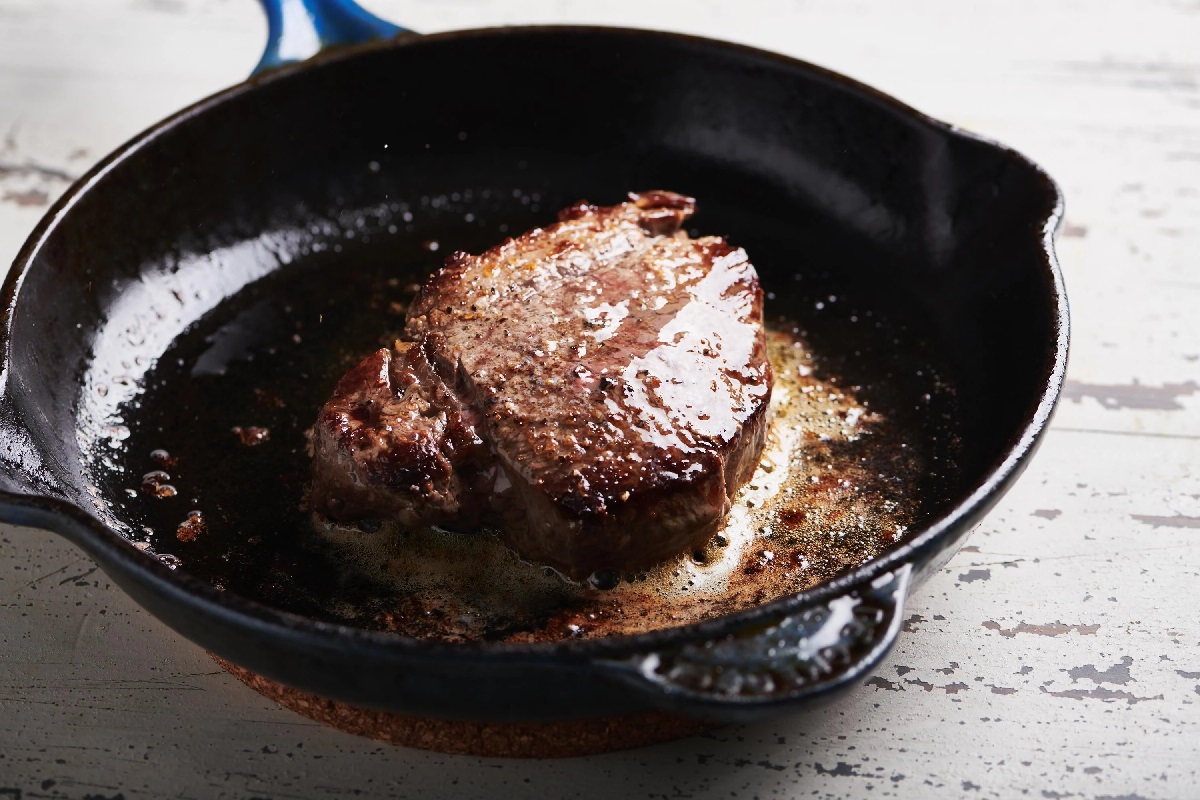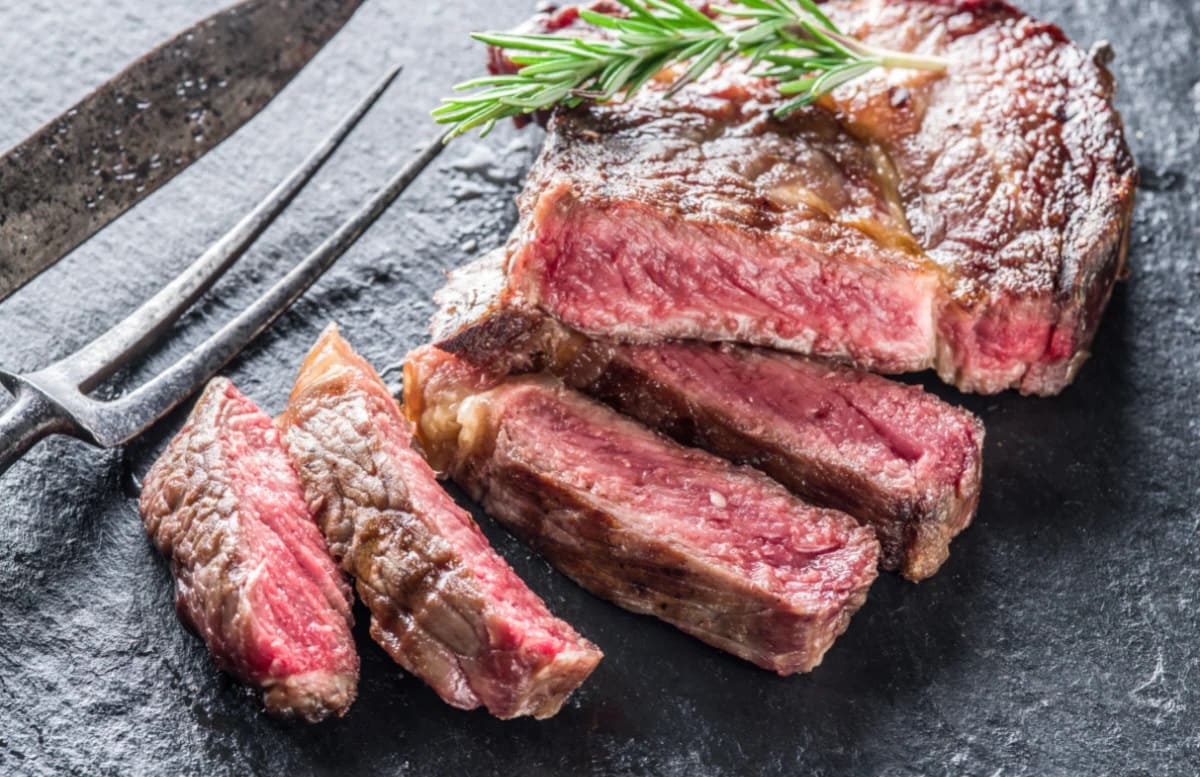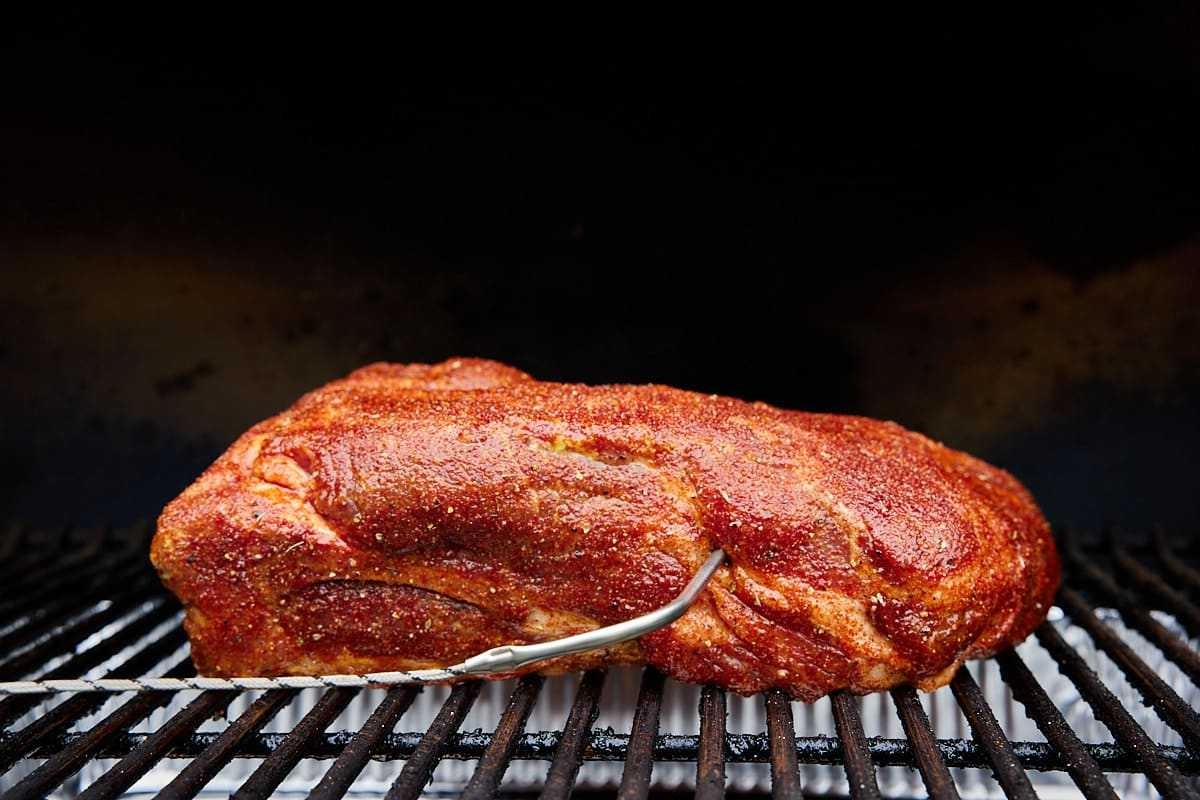Home>Culinary & Beverages>Optimal Internal Temperature For Cooking Pork


Culinary & Beverages
Optimal Internal Temperature For Cooking Pork
Published: February 21, 2024
Discover the ideal internal temperature for cooking pork to perfection. Explore culinary and beverage tips for delicious pork dishes. Unlock the secrets to perfect pork cooking.
(Many of the links in this article redirect to a specific reviewed product. Your purchase of these products through affiliate links helps to generate commission for Temperatures.com, at no extra cost. Learn more)
Table of Contents
The Importance of Internal Temperature
The internal temperature of pork is a critical factor in ensuring that it is safe to consume and has the desired texture and flavor. When cooking pork, it is essential to reach the optimal internal temperature to eliminate harmful bacteria and parasites that may be present in the meat. Consuming undercooked pork can pose serious health risks, including foodborne illnesses such as trichinosis, salmonella, and E. coli.
Moreover, achieving the correct internal temperature is vital for the overall quality of the cooked pork. It directly impacts the tenderness, juiciness, and flavor of the meat. Cooking pork to the appropriate internal temperature ensures that it is safe to eat while preserving its succulence and taste.
Furthermore, understanding the significance of internal temperature in pork cooking is crucial for both home cooks and professional chefs. By adhering to recommended internal temperature guidelines, individuals can confidently prepare pork dishes that are not only delicious but also safe for consumption.
In summary, the internal temperature of pork plays a pivotal role in guaranteeing food safety and achieving the desired texture and flavor. By prioritizing the attainment of the optimal internal temperature, individuals can savor delectable pork dishes while safeguarding their health.
Read more: Optimal Internal Temperature For Meatloaf
Factors Affecting Pork's Internal Temperature
The internal temperature of pork is influenced by several key factors that impact the cooking process and the final outcome of the dish. Understanding these factors is essential for achieving the optimal internal temperature and ensuring the safety and quality of the cooked pork.
1. Cut and Thickness of the Pork
The cut and thickness of the pork significantly affect its internal temperature. Thicker cuts of pork, such as pork chops or roasts, require longer cooking times to reach the recommended internal temperature. Conversely, thinner cuts, like pork tenderloin or cutlets, cook more quickly due to their reduced thickness. It is crucial to adjust cooking times and methods based on the specific cut and thickness of the pork to achieve the desired internal temperature evenly throughout the meat.
2. Starting Temperature of the Pork
The starting temperature of the pork before cooking can impact the cooking duration and the internal temperature achieved. Pork that is taken directly from the refrigerator will require longer cooking times to reach the recommended internal temperature compared to pork that has been brought to room temperature beforehand. Allowing the pork to come to room temperature before cooking can help ensure more even cooking and reduce the risk of overcooking the exterior while waiting for the interior to reach the desired temperature.
3. Cooking Method and Equipment
The cooking method and equipment utilized also play a significant role in determining the internal temperature of pork. Whether grilling, roasting, pan-searing, or slow-cooking, each method requires different cooking times and temperatures to reach the recommended internal temperature. Additionally, the type of cooking equipment, such as ovens, grills, or stovetops, can affect the heat distribution and cooking efficiency, influencing the internal temperature achieved in the pork.
4. Resting Period After Cooking
The resting period after cooking is a crucial factor that impacts the final internal temperature of pork. Allowing the cooked pork to rest for a few minutes before slicing or serving enables the internal temperature to continue rising slightly, a process known as carryover cooking. This resting period helps ensure that the pork reaches the optimal internal temperature throughout, contributing to its succulence and tenderness.
5. Stuffing and Additions
If preparing stuffed pork dishes or incorporating additional ingredients, such as fillings or marinades, it is important to consider their impact on the internal temperature. The presence of stuffing or added components can affect the cooking time and the distribution of heat within the pork, potentially influencing the attainment of the recommended internal temperature.
In summary, the internal temperature of pork is influenced by various factors, including the cut and thickness of the pork, its starting temperature, the cooking method and equipment used, the resting period after cooking, and the presence of stuffing or additional ingredients. By taking these factors into account, individuals can effectively manage the cooking process to achieve the optimal internal temperature, ensuring both the safety and quality of the cooked pork.
Recommended Internal Temperature for Cooking Pork
The recommended internal temperature for cooking pork is a critical guideline that ensures the safety and palatability of pork dishes. It is essential to adhere to these temperature recommendations to eliminate harmful bacteria and parasites while preserving the succulence and flavor of the meat.
The United States Department of Agriculture (USDA) advises that whole cuts of pork, such as chops, roasts, and steaks, should reach an internal temperature of 145°F (63°C) as measured with a food thermometer. Once this temperature is reached, the pork is considered safe to consume, with the juices running clear and the meat exhibiting a slightly pink hue. This temperature recommendation reflects advancements in food safety and the understanding that pork can be consumed safely at a lower internal temperature, resulting in juicier and more flavorful dishes.
For ground pork, including sausages and patties, the recommended internal temperature is slightly higher, at 160°F (71°C). This higher temperature requirement for ground pork products is attributed to the increased risk of bacterial contamination due to the grinding process, which exposes a larger surface area of the meat to potential contaminants. By ensuring that ground pork reaches the recommended internal temperature, individuals can mitigate the risk of foodborne illnesses and enjoy safe and delectable pork dishes.
It is important to note that these recommended internal temperatures are based on scientific research and food safety standards, aiming to protect consumers from the potential hazards associated with undercooked pork. By diligently using a food thermometer to verify that pork reaches the specified internal temperatures, individuals can confidently prepare and savor a wide array of pork dishes, ranging from tender pork chops to succulent pork roasts and flavorful ground pork recipes.
In summary, the recommended internal temperatures for cooking pork, as outlined by the USDA, are 145°F (63°C) for whole cuts and 160°F (71°C) for ground pork. Adhering to these temperature guidelines is crucial for ensuring the safety and quality of pork dishes, allowing individuals to relish the rich flavors and textures of well-prepared pork while safeguarding their well-being.
Tips for Achieving Optimal Internal Temperature
-
Use a Meat Thermometer: Investing in a reliable meat thermometer is indispensable for accurately gauging the internal temperature of pork. By inserting the thermometer into the thickest part of the meat, away from bones and fat, individuals can ensure precise readings, thereby avoiding undercooking or overcooking the pork. Digital instant-read thermometers provide quick and accurate results, enhancing the cooking experience and yielding perfectly cooked pork dishes.
-
Avoid Overcooking: While it is crucial to reach the recommended internal temperature, overcooking pork can result in dry, tough meat. To prevent this, it is advisable to remove the pork from the heat source when it is a few degrees below the target temperature. The residual heat will continue to raise the internal temperature slightly during the resting period, allowing the pork to reach the desired doneness without becoming overcooked.
-
Consider Carryover Cooking: Understanding the concept of carryover cooking is essential for achieving the optimal internal temperature in pork. After removing the pork from the heat source, it continues to cook as the internal temperature gradually rises. Allowing for this additional cooking time during the resting period ensures that the pork reaches the recommended temperature uniformly, resulting in succulent and tender meat.
-
Adjust Cooking Methods: Different cooking methods, such as grilling, roasting, or braising, require adjustments to achieve the optimal internal temperature. For example, when grilling pork, searing the meat over high heat before finishing it over indirect heat can help achieve the desired internal temperature without charring the exterior. Similarly, when roasting pork, utilizing a meat thermometer to monitor the temperature throughout the cooking process ensures consistent and accurate results.
-
Utilize Proper Resting Time: Allowing the cooked pork to rest before slicing or serving is crucial for achieving the optimal internal temperature. During this resting period, the residual heat distributes evenly throughout the meat, ensuring that it reaches the recommended temperature while enhancing its juiciness and tenderness. The resting period also allows the juices to redistribute, resulting in a more flavorful dining experience.
-
Consider Pre-Brining or Marinating: Preparing pork with brines or marinades can enhance its flavor and juiciness while aiding in achieving the optimal internal temperature. Brining pork in a saltwater solution or marinating it with flavorful ingredients not only adds depth to the taste but also helps the meat retain moisture during the cooking process, contributing to a delectably tender and succulent outcome.
Incorporating these tips into the pork cooking process empowers individuals to achieve the optimal internal temperature consistently, resulting in safe, flavorful, and tender pork dishes that are sure to delight the palate.
Checking Internal Temperature with a Meat Thermometer
Accurately checking the internal temperature of pork is a fundamental aspect of ensuring its safety and palatability. A meat thermometer is an indispensable tool that provides precise readings, allowing individuals to gauge the doneness of pork with confidence. When using a meat thermometer to check the internal temperature of pork, several key steps should be followed to guarantee accurate results and a delightful dining experience.
Selecting the Right Thermometer
Choosing the appropriate meat thermometer is the first step in accurately checking the internal temperature of pork. Digital instant-read thermometers are highly recommended for their speed and accuracy. These thermometers provide quick readings, allowing individuals to monitor the temperature without prolonged exposure to heat. Additionally, digital thermometers can be inserted into the thickest part of the pork, away from bones and fat, to obtain the most accurate readings.
Inserting the Thermometer Correctly
Proper insertion of the meat thermometer is crucial for obtaining an accurate internal temperature reading. When checking the temperature of pork, the thermometer probe should be inserted into the thickest part of the meat, ensuring that it does not touch any bones, gristle, or fat deposits. This placement provides a true representation of the internal temperature of the pork, enabling individuals to make informed decisions about the doneness of the meat.
Monitoring the Temperature Progression
As the meat thermometer is inserted into the pork, it is essential to monitor the temperature progression carefully. The thermometer should be left in place for a few seconds to allow the reading to stabilize. This ensures that the displayed temperature accurately reflects the internal temperature of the pork at that specific location. By observing the temperature progression, individuals can determine whether the pork has reached the recommended internal temperature for safe consumption.
Verifying Consistency
When checking the internal temperature of pork, it is beneficial to verify the consistency of the readings. This can be achieved by taking multiple temperature readings from different areas of the pork, especially in thicker cuts or larger roasts. Consistent temperature readings throughout the meat indicate uniform doneness, ensuring that the entire pork dish is safe to consume and has reached the desired level of succulence and flavor.
Ensuring Safe Consumption
Once the meat thermometer indicates that the pork has reached the recommended internal temperature, it is crucial to confirm the safety of the dish. For whole cuts of pork, such as chops and roasts, the USDA recommends an internal temperature of 145°F (63°C). Ground pork products, including sausages and patties, should reach an internal temperature of 160°F (71°C) to ensure their safety. By adhering to these temperature guidelines and using a meat thermometer to verify the attainment of the specified temperatures, individuals can confidently enjoy safe and delectable pork dishes.
In summary, checking the internal temperature of pork with a meat thermometer is a precise and reliable method for ensuring the safety and doneness of pork dishes. By selecting the right thermometer, inserting it correctly, monitoring the temperature progression, verifying consistency, and confirming safe consumption, individuals can master the art of achieving the optimal internal temperature in pork, resulting in flavorful, tender, and safe-to-eat culinary creations.
Resting Period After Cooking
The resting period after cooking is a crucial phase in the preparation of pork dishes, playing a significant role in ensuring that the meat reaches the optimal internal temperature while enhancing its overall texture and flavor. When pork is removed from the heat source, whether it's from the oven, grill, or stovetop, it undergoes a process known as carryover cooking. During this period, the internal temperature of the pork continues to rise slightly, contributing to its uniform doneness and succulence.
Allowing the cooked pork to rest for a few minutes before slicing or serving is essential for several reasons. Firstly, the resting period enables the redistribution of the meat's internal juices, ensuring that they are evenly distributed throughout the pork. This process contributes to the overall juiciness and tenderness of the meat, enhancing the dining experience for those enjoying the dish.
Moreover, the resting period allows the muscle fibers within the pork to relax, resulting in a more tender and palatable texture. As the pork rests, the residual heat within the meat facilitates the breakdown of connective tissues, further contributing to its tenderness. This natural tenderization process, coupled with the redistribution of juices, ensures that each bite of the pork is flavorful and satisfying.
Additionally, the resting period after cooking provides individuals with an opportunity to monitor the internal temperature of the pork. As the meat continues to cook slightly during this phase, it ensures that the pork reaches the recommended internal temperature uniformly. This is particularly important for thicker cuts of pork, as the resting period allows the heat to penetrate the meat evenly, guaranteeing that it is safe to consume.
From a practical standpoint, the resting period offers individuals the chance to prepare accompanying side dishes, set the table, or attend to other culinary tasks before serving the pork. This brief interlude not only contributes to the overall timing and coordination of the meal but also allows the flavors of the pork to settle and develop, enhancing the overall dining experience.
In summary, the resting period after cooking is a critical component of the pork preparation process, contributing to the attainment of the optimal internal temperature, enhancing the tenderness and juiciness of the meat, and allowing for the development of flavors. By acknowledging the significance of this phase and incorporating it into the cooking routine, individuals can elevate their pork dishes to new heights, ensuring that each serving is a delectable and satisfying culinary delight.
Safety Precautions for Cooking Pork
When handling and cooking pork, it is essential to observe safety precautions to ensure the well-being of those consuming the meat. By adhering to these precautions, individuals can mitigate the risk of foodborne illnesses and guarantee the safe and enjoyable consumption of pork dishes.
-
Sanitary Practices: Prior to handling pork, it is crucial to practice good hygiene. This includes washing hands thoroughly with soap and warm water before and after handling raw pork. Additionally, all utensils, cutting boards, and surfaces that come into contact with raw pork should be washed with hot, soapy water to prevent cross-contamination with other foods.
-
Storage and Thawing: Proper storage and thawing of pork are vital for maintaining its quality and safety. Raw pork should be stored in the refrigerator at 40°F (4°C) or below to prevent bacterial growth. When thawing frozen pork, it is recommended to do so in the refrigerator, microwave, or cold water, never at room temperature, to avoid the risk of bacteria multiplying in the meat.
-
Avoiding Cross-Contamination: Preventing cross-contamination is paramount when handling raw pork. It is essential to keep raw pork separate from other foods, especially those that will not be cooked, to prevent the spread of harmful bacteria. This includes using separate cutting boards, utensils, and storage containers for raw pork to minimize the risk of contamination.
-
Cooking to Recommended Temperatures: Adhering to the recommended internal temperatures for pork is a fundamental safety precaution. Whole cuts of pork, such as chops and roasts, should reach an internal temperature of 145°F (63°C), while ground pork products, including sausages and patties, should reach 160°F (71°C). Using a meat thermometer to verify these temperatures is essential for ensuring that the pork is safe to consume.
-
Avoiding Partial Cooking: Partially cooking pork and then finishing the cooking process later can pose significant risks. It is important to cook pork thoroughly in one continuous session to ensure that harmful bacteria, such as salmonella and E. coli, are eliminated, reducing the likelihood of foodborne illnesses.
-
Proper Storage of Leftovers: When storing leftover cooked pork, it should be refrigerated promptly at 40°F (4°C) or below to prevent the growth of bacteria. Leftover pork should be consumed within a safe timeframe to maintain its quality and safety, typically within 3-4 days when refrigerated.
By diligently following these safety precautions, individuals can confidently handle and cook pork, minimizing the risk of foodborne illnesses and ensuring that pork dishes are not only delicious but also safe for consumption. Prioritizing food safety measures when working with pork is essential for promoting the well-being of those enjoying the culinary creations derived from this versatile and flavorful meat.












